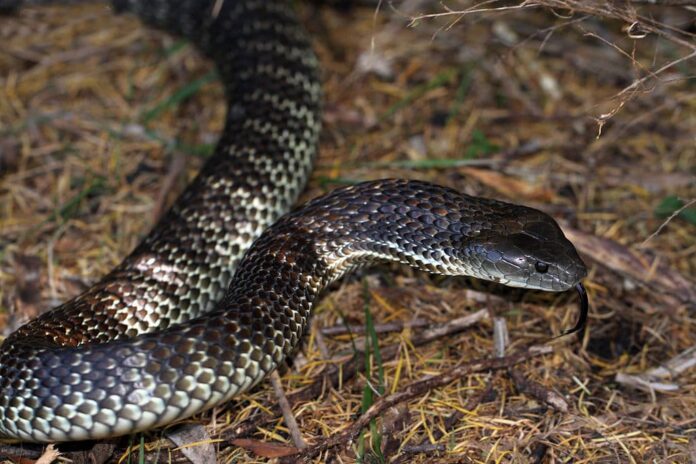I love searching about deadly animals in Australia, but I want to focus on some of the most venomous snakes today. Many people know that there are many malicious animals on this continent, but what are they? There are over 150 snake species in Australia, and at least 100 of them are venomous. However, we are only going to talk about the ones that are fatal to humans. You will get to know some of the most venomous snakes in Australia, so let’s take a look.
1Coastal Taipan
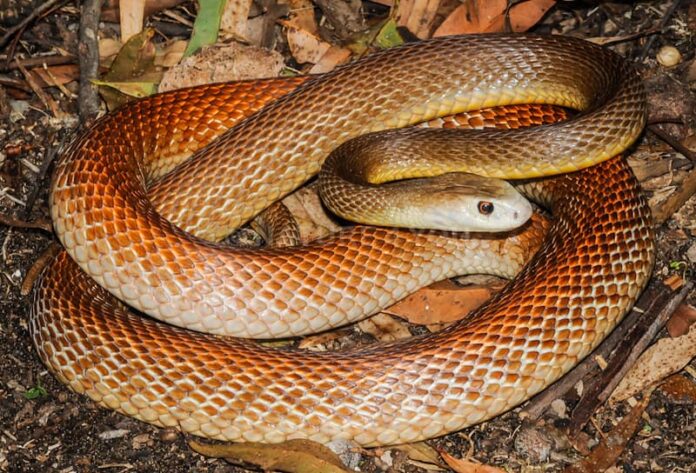
Living in the coastal regions of eastern and northern Australia, coastal taipans are extremely large and venomous snakes to avoid. In spite of the name, these large snakes are found in different habitats hundreds of miles away from the ocean. This is one of the reasons to fear them because the chance of coming across these snakes is also common. Sometimes they go out to hunt, and coastal taipans are very selective with what they eat. In fact, they only feed on warm-blooded animals such as bandicoots, birds, mice, rats, etc.
As one of the snakes with the longest fangs, injecting their venom is very easy for them. Plus with the fact that these snakes have the third most toxic venoms, bites from them are not pleasant. The venom from coastal taipans affects the blood and nervous system which results in convulsions, internal bleeding, kidney damage, and more. In severe cases, death can occur within 30 minutes due to the powerful myotoxin in the snake’s venom.
2Australian Copperhead
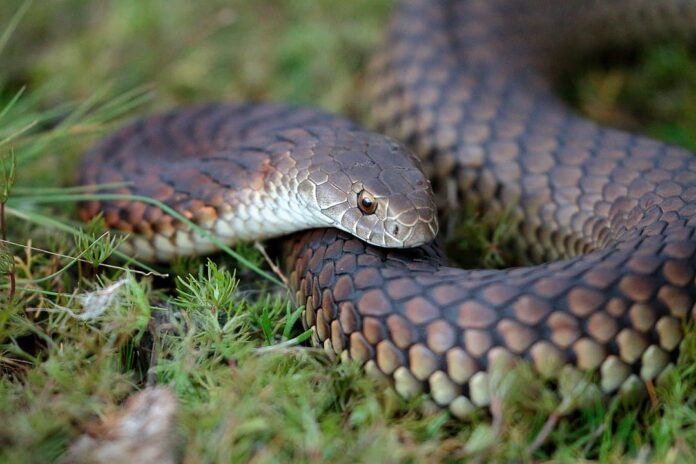
There are 3 species of Australian copperhead snakes including highland copperhead, lowland copperhead, and pygmy copperhead. All three of them are venomous, and they live in different parts of Australia, so all of them are known as copperheads. Highland copperheads inhabit the Alpine regions of eastern Australia, mostly in sclerophyll forests and woodlands along water bodies, and swampy areas. Lowland copperheads are found in southeastern Australia and Tasmania, in low vegetation areas near water bodies. Pygmy copperheads are the common ones but rarely seen, and they are endemic to South Australia, especially on Kangaroo Island.
The venom from these 3 species contains neurotoxic venom which is capable of killing an adult human. Once bitten, the patient should seek medical attention immediately before the venom causes blood cell rupture and muscles damages. The good thing is that copperheads are shy so they prefer to avoid humans, and they will not bite unless provoked. When cornered, the snake will hiss loudly, flatten its body, and flick or thrash out, usually without biting. If you don’t back up, they will strike. If you go hiking, wear gumboots or strong shoes to protect your legs because their fangs are short. That at least helps provide extra protection in case you accidentally step on them.
3Common Death Adders
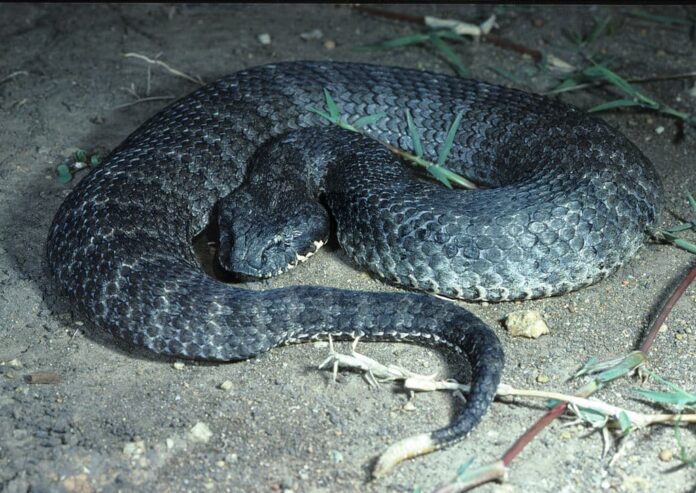
The bites from the common death adders are not painful, but the after-effects are absolutely excruciating. This reptile is Australia’s most dangerous and venomous ambush predator that sits motionlessly and waits for the prey to come before striking. While most snakes flee from approaching humans, this one remains still under leaf litter, risking being stepped on. This makes it even more dangerous because one wrong step, and you will have a high chance of getting bitten.
Native to Australia, the common death adders go by a lot of deadly reputations. Apart from being one of the most dangerous and venomous snakes, they also have the longest fangs among Australian snakes. At the same time, they are the masters of camouflage both during the day and at night. The good thing is that death adders are not aggressive, and they only bite when provoked such as by picking up or touching.
Venoms from this snake are very potent due to the large proportion of toxins that cause loss of motor and sensory function. One bite, and the victim will start to experience abdominal pain, drowsiness, enlargement of regional lymph nodes, headache, and muscle paralysis. Those follow by difficulty breathing due to respiratory failure which results in paralysis and death. Dry bites, when the bite is not injected with venom, are also common as warning bites which are not dangerous.
4Dugite
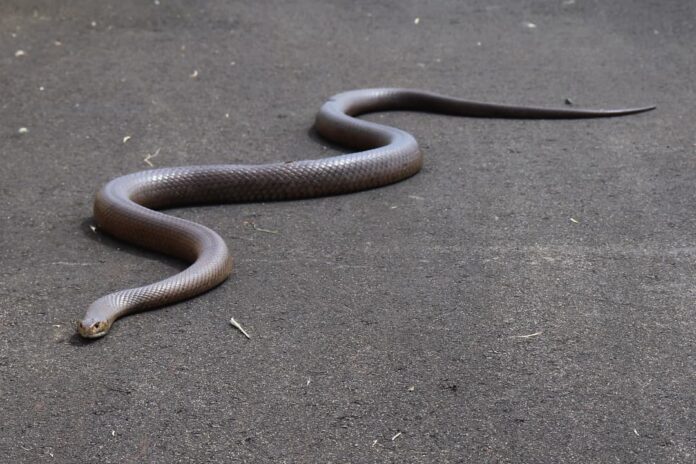
Some snakes are venomous but not dangerous, but this is not the case with dugite. These snakes are both venomous and dangerous, and they are common in southern parts of Western Australia. Dugite lives in a wide range of habitats such as coastal dunes, heathlands, shrubs, and woodlands, sheltering beneath logs or rocks. In Perth, dugites are one of the most common snakes found next to the building where mice are abundant.
Dugites are very shy, so they will slither away when disturbed and they generally avoid biting humans. However, they do not hesitate to bit to defend themselves if cornered. The thing is that their behavior changes during the mating season so they will likely bite. The venom of dugites is one of the most lethal in the world, causing paralysis and death without immediate medical attention.
5Eastern Brown Snake
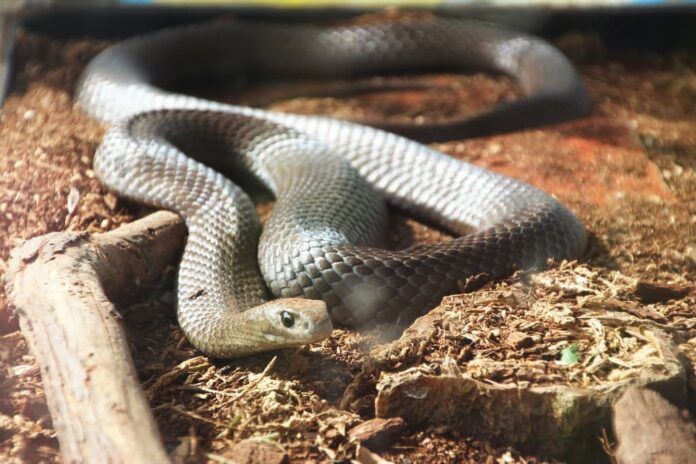
Since they are the second most venomous snakes in the world, we have many reasons to avoid eastern brown snakes. First and foremost, the eastern brown snakes have a bad temper and they are very aggressive. Moody snakes with deadly venom are definitely the type to not mess with. There are 9 species of brown snakes, and all of them are highly venomous. Even the juveniles of this species can deliver deadly bites. Even worse, these snakes thrive in populated areas especially on farms in rural areas where mice are abundant.
The eastern brown snakes are generally solitary, females and younger males usually avoid adult males. During mating season, males take part in ritual combat with other males for mating opportunities with females. The opponents braid their bodies together and push down on each other’s heads, trying the other side’s head to the ground. As polygynous, a male eastern brown snake mates with several females. So the most dominant male will mate with all the females in the area, for several hours.
Eastern brown snakes are very fast-moving, and an Australian naturalist reported that they could outpace a person running at full speed. When disturbed, an eastern brown snake will raise its body off the ground, winding into an S shape with its mouth gaping open. If you get any close, it will not hesitate to snake. The venom of these snakes contains textilotoxin that causes progressive paralysis and destructs nerve tissue, resulting in central nervous system damage. Without immediate medical attention, a bite can lead to fatality although the case is rare due to the availability of antidotes.
6Inland Taipan
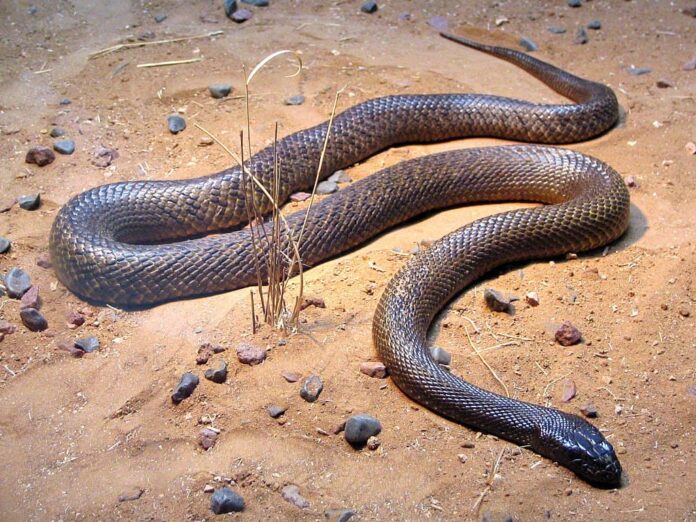
Fast-moving and large, the inland taipans are dangerous snakes endemic to Australia and New Guinea. At the same time, these are also one of the most highly venomous snakes in Australia and the world as well. That is because they are known to have the most toxic venom of any terrestrial snakes in the world. Compared to the coastal taipan, this species is smaller but they are both deadly and venomous. The inland taipan almost always injects venom when it bites, and those short fangs can deliver a great amount of venom.
Another nickname of the inland taipan is a fierce snake, and there are many reasons why. Inland taipans are highly agile and fast, and they can strike instantly with extreme accuracy. Even worse, these snakes often strike multiple times in the same attack, making them even more dangerous. Their toxic venom can kill an adult human in just 45 minutes or faster, depending on the nature of the bite. Their venom contains myotoxins, neurotoxins, and procoagulants that result in a quick and painful death. Although these snakes are shy, they will strike to defend themselves if cornered, mishandled, and provoked.
7King Brown Snake
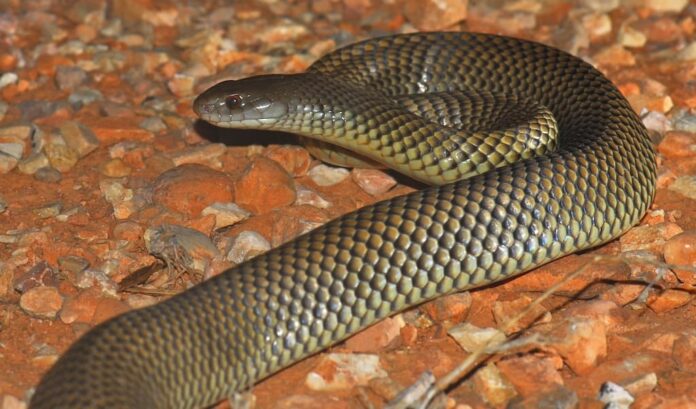
Mulga snake is another name for the king brown snake, and it is a highly venomous snake in mainland Australia. King brown snakes are Australia’s most widespread venomous snakes since their population is almost everywhere except extreme south and southeast coastal regions. These snakes are very adaptable, and their habitats are in almost any type of environment in the country. Those include chenopod shrubland, dry open forests, heath, gibber deserts, hummock grassland, Mulga woodlands, open woodlands, savannah, and more.
Another interesting thing about mulga snakes is their large and robust appearance. These snakes are the heaviest venomous snakes in Australia as well as among the longest venomous snakes in the world. When they bite, they even hang on and chew as they inject massive amounts of highly toxic venom. The venom of mulga snakes affects muscles and nerves and destroys blood cells, causing hemorrhaging, kidney damage, renal failure, etc.
8Rough-Scaled Snake
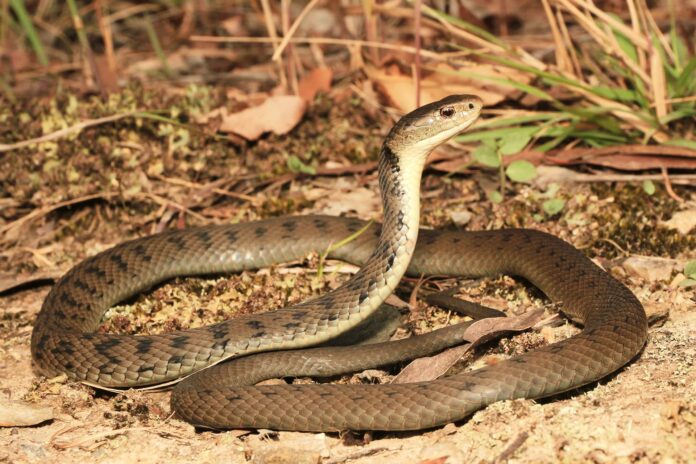
Hikers have a higher chance to encounter these venomous snakes since their habitats are in heaths, moist forests, rainforests, etc. Their range is from mid-eastern New South Wales to the tip of far-north Queensland of Australia. Rough-scaled snakes are active both day and night, and they are capable of climbing trees to catch prey. These snakes like to live by themselves due to their shy and nervous nature, but they are very aggressive when disturbed.
A rough-scaled snake will raise its forebody in an S shape and hiss loudly when in a defensive position. This shows that it is ready to strike, and it will bite if an intruder keeps on approaching. When biting, it will strike repeatedly multiple times before trying to escape. Their venom contains coagulant, cytotoxic, haemolytic, and neurotoxic properties which can be fatal without proper medication on time.
9Strap-Snouted Brown Snake
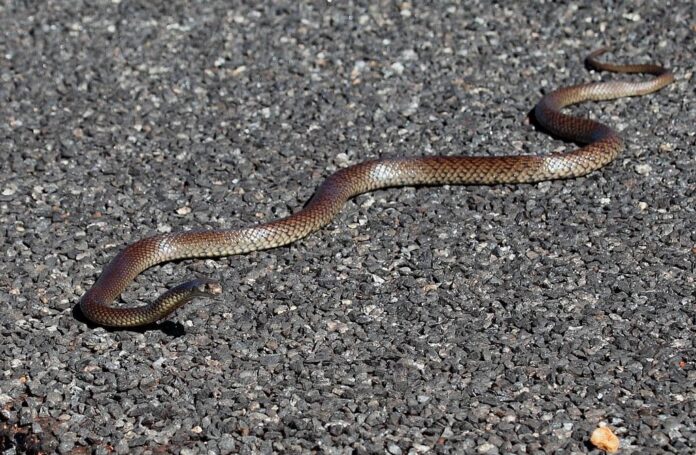
The strap-snouted snakes are one among the venomous snakes native to different parts of Australia. They live in dry arid and semiarid areas, malle, and woodlands where they feed on lizards, mammals, and other small snakes. The interesting thing about them is that they have keen eyesight, and they are very cautious with things around them. Strap-snouted brown snakes respond quickly to movement nearby, especially prey and predators. Their venom is very dangerous to humans, and a bite from them can be fatal.
10Tiger Snake
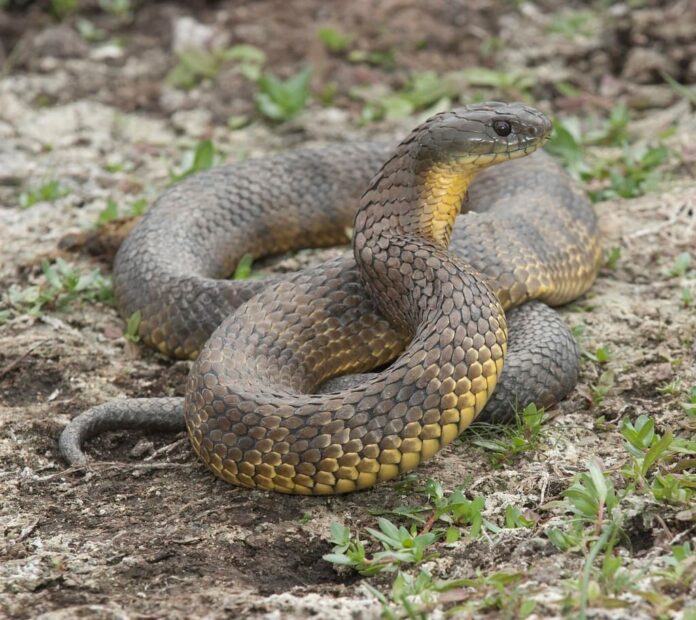
And lastly, we have another highly venomous snake species in the southern regions of Australia and Tasmania. These reptiles live in subtropical and temperate parts such as lagoons, open forests, swamps, and other areas near rivers. Just like the name suggests, tiger snakes often have stripes on their bodies that are similar to those of tigers. The fascinating part is that these snakes can climb trees, dive, and swim in the water. In fact, they can submerge and spend up to 9 minutes underwater.
Tiger snakes are only aggressive during the mating season, and the males will fight each other to mate a female. Even if they are not aggressive, they will attack and bite humans for self-defense purposes. As one of the deadly snakes, the venom of tiger snakes contains strong neurotoxins that can be fatal to humans. The symptoms from their bites are localized pain, numbness, sweating, and tingling, then followed by breathing difficulties and paralysis.
Related Post: Most Dangerous Animals In Australia

